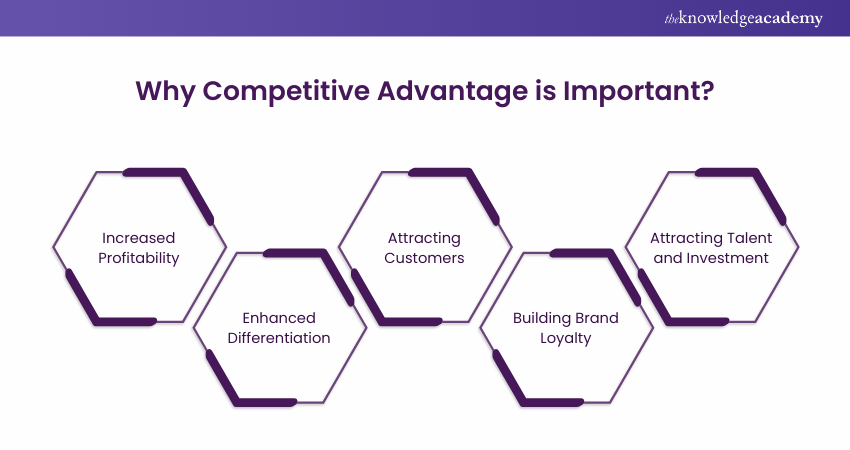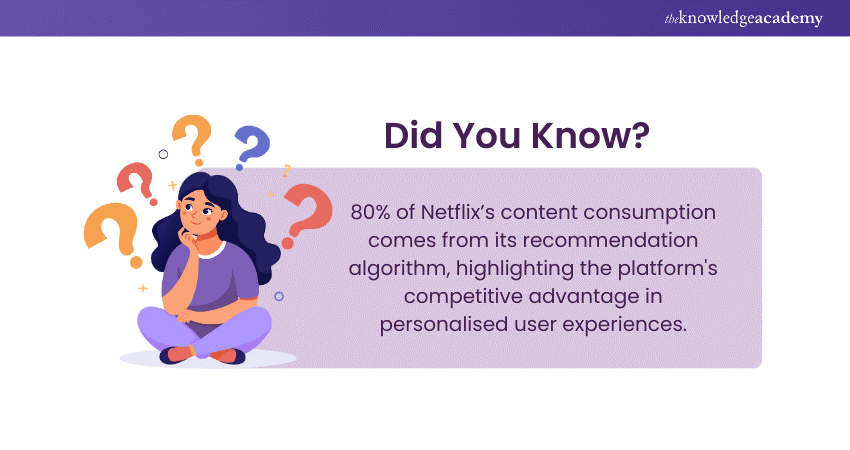We may not have the course you’re looking for. If you enquire or give us a call on +44 1344 203 999 and speak to our training experts, we may still be able to help with your training requirements.
Training Outcomes Within Your Budget!
We ensure quality, budget-alignment, and timely delivery by our expert instructors.

When it comes to business, surviving and thriving can be two very radically different experiences. After all, the dream of any business is to stand out and keep the customer base growing and coming back for more. This is where the concept of Competitive Advantage comes in in the form of unique products, exceptional services or innovative strategies. In short, it’s the hottest fuel for business success.
If you are racking your brains over how to stay ahead of the pack, look no further! This blog dives into What is Competitive Advantage, detailing its importance in ensuring thriving businesses. Read on and gain supreme edge over your market rivals!
Table of Contents
1) What is Competitive Advantage?
2) Examples of Competitive Advantage
3) The Importance of Competitive Advantage
4) Elements of Competitive Advantage
5) How Competitive Advantage Functions?
6) Strategies for Gaining Competitive Advantage
7) Conclusion
What is Competitive Advantage?
Competitive Advantage refers to how a company can deliver goods or services better than its competitors. It enables a company to achieve superior margins and generate shareholder value. Competitive Advantages are attributed to diverse factors, including branding, cost structure, the quality of product offerings, the distribution network, intellectual property, and customer service.
However, a Competitive Advantage cannot be replicated easily and is exclusive to a business. It's a value created internally that sets the business apart from its competition.
The Purpose of Competitive Advantage
The purpose of a Competitive Advantage is to differentiate a company from its competitors by providing something distinct and of superior value to its customers. Additionally, Competitive Advantage implies that the business can outperform its competition in the market and generate a higher profit.
Examples of Competitive Advantage
Competitive Advantage distinguishes a thriving business from a surviving one, but the source can change from company to company and sector to sector. Some common examples of Competitive Advantage include:
1) The team
2) A product that no one else can offer (protected by patents, IP law, etc.)
3) Unique access to production methods
4) Ability to manufacture and sell at a lower cost (also known as cost leadership)
5) Brand and reputation
However, it's important to remember that while you may launch a novel idea, rivals may soon catch up. That’s when you may have to revisit what your Competitive Advantage can be.
The Importance of Competitive Advantage
No matter which area you’re targeting, there’s countless competition cropping up in the volatile corporate landscape. So, having the upper hand is crucial for success. The importance of Competitive Advantage is outlined in the points below:

Differentiation
Your product or service must deliver unique features, superior overall quality, or innovative solutions. Customers are always seeking something distinct that makes your brand the obvious choice.
Profitability
You may charge a little extra to charge up your profit margins by providing something the competitors can't easily replicate. This helps you capture a bigger market share and achieve greater profits.
Attracting Customers
Competitive Advantage helps attract and retain customers, developing a loyal customer base that can offer repeat business and positive word-of-mouth referrals in return.
Building Brand Loyalty
Competitive Advantage builds brand loyalty among customers because customers who recognise your business's unique value are likelier to develop an emotional connection to your brand.
Attracting Talent and Investment
Employees are drawn to innovative companies that provide growth opportunities. As a bonus, investors are likelier to invest in companies that has a clear Competitive Advantage, which implies a higher potential for long-term success.

Source: The Netflix Recommender System
Elements of Competitive Advantage
To establish a Competitive Advantage, you must have a deep insight into the following elements:
1) Value Proposition: A company must identify the services or features that make it attractive to customers and provide real value to generate interest.
2) Target Market: A company must establish its target market to ingrain best practices further to strengthen competitiveness.
3) Competitors: A company must define its market competitors and research their value, including emerging competition.
Expand your expertise in supply chain Risk Management through our comprehensive CIPS Level 5 Advanced Diploma in Procurement and Supply Course – Sign up now!
How Competitive Advantage Functions
There are three major factors in business that determine how a company structures its Competitive Advantage. These factors are outlined below:
Market Analysis
Knowing your target market and how it might impact your business's general growth is crucial. Companies may credit lower-priced goods or services, quality products, or a unique selling point for their Competitive Advantage. To gain broader insight into your target market, you can try a few different methods, such as:
a) Gathering data about competing companies' products and selling points
b) Conducting customer surveys
c) Identifying selling trends for certain products during different seasons
d) Getting feedback on marketing and sales strategies
Strategy Implementation
A business can implement strategies that could help position its products ahead of the competition. For instance, a hair and makeup business might focus on rebranding its products to make them stand out. Another way Competitive Advantage works is through identification of the target audience and implementing the most appropriate strategy.
Performance Monitoring
A business can monitor its strategy to adjust areas that aren't as effective and focus more resources on successful ones, which can further its Competitive Advantage. For example, a beauty products company whose Competitive Advantage is its social media platforms can track the number of new customers referred to it through its social media accounts.
Monitoring this information helps create more avenues for fresh clients to sign up for their products, such as referral programs or bonuses.
Strategies for Gaining Competitive Advantage
Now that you've got an understanding of the importance of Competitive Advantage, let's explore the three main strategies for developing Competitive Advantage as outlined below:
Cost Leadership
This strategy aims to become the lowest-cost or most efficient producer. If your company can produce products at a lower cost than your competition, a selling price can be established that your rivals can't duplicate. To be the lowest-cost producer, you can try:
a) Use bargaining power to negotiate for lower production prices
b) Using technology more effectively in production
c) Decreasing waste
d) Training employees better
e) Decreasing downtime for machines
Differentiation
The differentiation strategy aims to provide your customers with a variation of a higher-quality product or to innovate products or services for which you can then set a premium price. Since differentiation occurs by adjusting aspects such as style, design, and performance, the ability to differentiate products can vary depending on their characteristics.
For example, items that are difficult to differentiate may include:
a) Paper
b) Sports equipment
c) Office supplies
d) Lumber
e) Meat
Meanwhile, items that are easier to differentiate include:
a) Furniture
b) Technology
c) Vehicles
d) Appliances
e) Video games
Focus
In this strategy, a company targets a specific market segment and attends to customers with unique needs by providing products or services specifically for them. This type of strategy falls under niche marketing, aiming to fill niche needs that competitors are not meeting.
This strategy has two main variants:
a) Differentiation-focus: Providing products or services in a narrow market segment.
b) Cost-focus: Being lowest-cost producer in a narrow market segment.
Conclusion
The business world is an ever-evolving landscape, and the only way to stay ahead is by creating a Competitive Advantage. This is the key to keeping your customers loyal and your brand unforgettable. Leveraging strategies like differentiation, cost leadership, and unique product creation can give your business a significant market edge. Overall, understanding What is Competitive Advantage, as detailed in this blog, is your key to a thriving business.
Learn how to develop a continuous business improvement plan and schedule through our Business Process Improvement Course – Register now!
Frequently Asked Questions

The three major types of Competitive Advantage are cost leadership, differentiation and focus.

Coca-Cola's Competitive Advantage includes:
a) Unique packaging
b) One-stop shops
c) The Image of a storyteller
d) Massive distribution system
e) Different innovative flavours

The Knowledge Academy takes global learning to new heights, offering over 30,000 online courses across 490+ locations in 220 countries. This expansive reach ensures accessibility and convenience for learners worldwide.
Alongside our diverse Online Course Catalogue, encompassing 19 major categories, we go the extra mile by providing a plethora of free educational Online Resources like News updates, Blogs, videos, webinars, and interview questions. Tailoring learning experiences further, professionals can maximise value with customisable Course Bundles of TKA.

The Knowledge Academy’s Knowledge Pass, a prepaid voucher, adds another layer of flexibility, allowing course bookings over a 12-month period. Join us on a journey where education knows no bounds.

The Knowledge Academy offers various CIPS Courses, including the CIPS Level 2 Certificate in Procurement and Supply Operations Course and the CIPS Level 6 Professional Diploma in Procurement and Supply Course. These courses cater to different skill levels, providing comprehensive insights into How to Improve Cash Flow.
Our Accounting and Finance Blogs cover a range of topics related to Competitive Advantage, offering valuable resources, best practices, and industry insights. Whether you are a beginner or looking to advance your business growth trajectory, The Knowledge Academy's diverse courses and informative blogs have got you covered.
Upcoming Accounting and Finance Resources Batches & Dates
Date
 CIPS Level 2 Certificate in Procurement and Supply Operations Course
CIPS Level 2 Certificate in Procurement and Supply Operations Course







 Top Rated Course
Top Rated Course



 If you wish to make any changes to your course, please
If you wish to make any changes to your course, please


